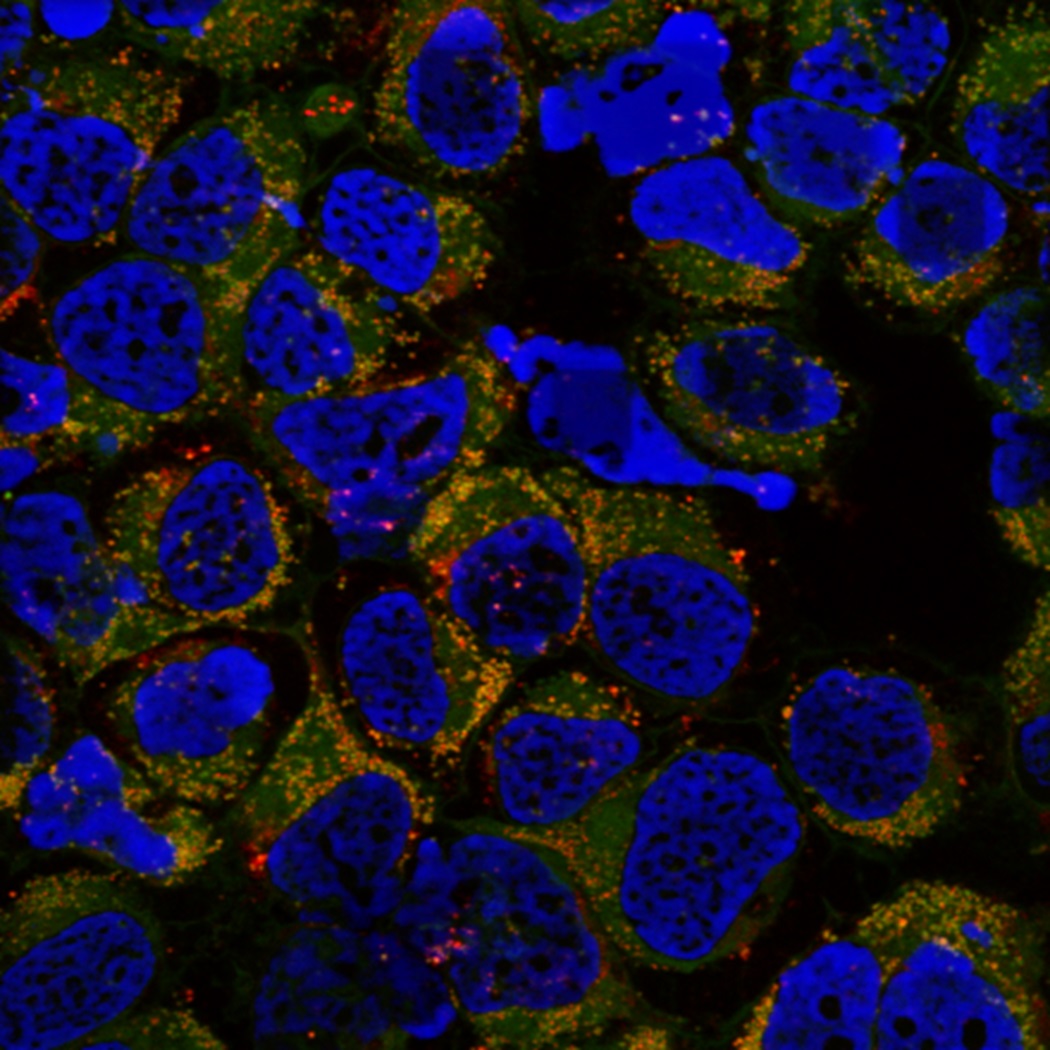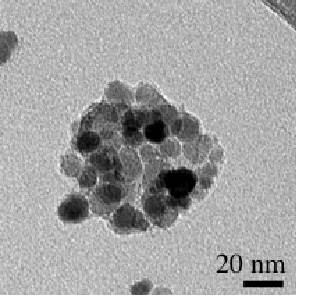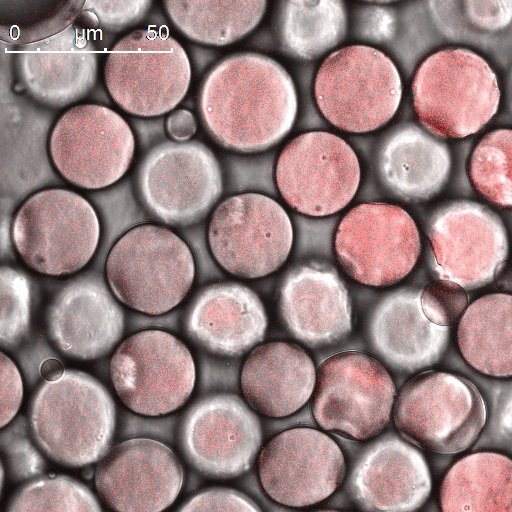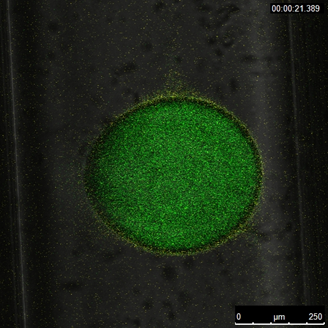Multifunctional Nanoparticles

Multifunctional Nanoparticle Fabrication for Efficient Therapeutic and Diagnostic Delivery
Researchers: Adam York, Robert K. Prud'homme
Current research involves the fabrication of multifunctional nanoparticles (NPs), via Flash NanoPrecipitation, for both diagnostic and/or therapeutic delivery applications. NP components (amphiphilic copolymers and hydrophobes) are synthesized with various reactive handles (i.e. amines, thiols, alkynes, azides, etc.) for functionalization with dyes, chelators, proteins and/or peptides prior to or after NP formulation. NP-cell interactions are then investigated to validate both diagnostic and therapeutic efficacies. Critical factors under examination include ligand density and placement, therapeutic loading and release, and NP biodistribution and half-life. Thanks to the versatility in available polymer chemistries and the ability of Flash NanoPrecipitation to produce narrowly dispersed NPs, functional nanomaterials with appropriate structure property/activity relationships are now feasible for the precise and efficient delivery of therapeutic and diagnostic agents in vivo.
Researchers: Adam York, Robert K. Prud'homme
Current research involves the fabrication of multifunctional nanoparticles (NPs), via Flash NanoPrecipitation, for both diagnostic and/or therapeutic delivery applications. NP components (amphiphilic copolymers and hydrophobes) are synthesized with various reactive handles (i.e. amines, thiols, alkynes, azides, etc.) for functionalization with dyes, chelators, proteins and/or peptides prior to or after NP formulation. NP-cell interactions are then investigated to validate both diagnostic and therapeutic efficacies. Critical factors under examination include ligand density and placement, therapeutic loading and release, and NP biodistribution and half-life. Thanks to the versatility in available polymer chemistries and the ability of Flash NanoPrecipitation to produce narrowly dispersed NPs, functional nanomaterials with appropriate structure property/activity relationships are now feasible for the precise and efficient delivery of therapeutic and diagnostic agents in vivo.
Formation of Stable Nanocarriers by in Situ Ion Pairing during Block-Copolymer-Directed Rapid Precipitation
Researchers: Nathalie M. Pinkerton, and Robert K. Prud'homme in collaboration with Andreas Fisch and Bernd U. Riebesehl (Novartis Pharma AG)
Nanoparticles (NP) are a promising approach for targeted drug delivery. Traditionally, NP formation of weakly hydrophobic, ionizable active pharmaceutical ingredients (APIs) via rapid precipitation processes is problematic. The intermediate API solubility makes achieving the required high supersaturation difficult during the precipitation process. Subsequently, the intermediate solubility causes rapid Ostwald ripening or recrystallization after precipitation. By forming a hydrophobic salt in situ, the API solubility and crystallinity can be tuned to allow for NC formation. Unlike covalent API modification, the hydrophobic salt formation modifies properties via ionic interactions, thus circumventing the need for full FDA re-approval. This technique greatly expands the types of APIs that can be successfully encapsulated in NC form.
Researchers: Nathalie M. Pinkerton, and Robert K. Prud'homme in collaboration with Andreas Fisch and Bernd U. Riebesehl (Novartis Pharma AG)
Nanoparticles (NP) are a promising approach for targeted drug delivery. Traditionally, NP formation of weakly hydrophobic, ionizable active pharmaceutical ingredients (APIs) via rapid precipitation processes is problematic. The intermediate API solubility makes achieving the required high supersaturation difficult during the precipitation process. Subsequently, the intermediate solubility causes rapid Ostwald ripening or recrystallization after precipitation. By forming a hydrophobic salt in situ, the API solubility and crystallinity can be tuned to allow for NC formation. Unlike covalent API modification, the hydrophobic salt formation modifies properties via ionic interactions, thus circumventing the need for full FDA re-approval. This technique greatly expands the types of APIs that can be successfully encapsulated in NC form.

Nanoparticles for Multimodal Imaging
Researchers: Nathalie M. Pinkerton, Robert K. Prud’homme in collaboration with Michael Therien (Duke)
Nanoparticle formulations of nanocrystalline materials and molecular fluorophores present unique opportunities for improved medical imaging and diagnostics via multiple imaging modalities. The combination of gold nanoparticles and Near IR dyes allows for dual CT and optical imaging. Flash Nanoprecipitation gives control of particle size and surface functionality for selective localization of multi-modal nanoparticles in tissue.
Researchers: Nathalie M. Pinkerton, Robert K. Prud’homme in collaboration with Michael Therien (Duke)
Nanoparticle formulations of nanocrystalline materials and molecular fluorophores present unique opportunities for improved medical imaging and diagnostics via multiple imaging modalities. The combination of gold nanoparticles and Near IR dyes allows for dual CT and optical imaging. Flash Nanoprecipitation gives control of particle size and surface functionality for selective localization of multi-modal nanoparticles in tissue.
MRI active Nanoparticles as Contrast Agents for Tumor Detection
Researchers: Nathalie M. Pinkerton, Marian Gindy, and Robert K. Prud'homme in collaboration with Carlos Rinaldi (Florida), Patrick J. Sinko (Rutgers), Carlos Pacheco (U Conn.)
Polymer directed rapid precipitation allows for the controlled formation of nanoparticles with superparamagnetic iron oxide (SPIO) nanocrystals for MRI imaging. The clustering of SPIO nanocrystals within a nanoparticle core creates imaging agents with high relaxivities and improved contrast. Through the simple precipitation process, active pharmaceutical ingredients can also be incorporated into the nanoparticle for theranostic applications.
Researchers: Nathalie M. Pinkerton, Marian Gindy, and Robert K. Prud'homme in collaboration with Carlos Rinaldi (Florida), Patrick J. Sinko (Rutgers), Carlos Pacheco (U Conn.)
Polymer directed rapid precipitation allows for the controlled formation of nanoparticles with superparamagnetic iron oxide (SPIO) nanocrystals for MRI imaging. The clustering of SPIO nanocrystals within a nanoparticle core creates imaging agents with high relaxivities and improved contrast. Through the simple precipitation process, active pharmaceutical ingredients can also be incorporated into the nanoparticle for theranostic applications.

Supramolecular assembly of polymer nanoparticles into functional nanoscale materials
Researchers: Chris Sosa, Robert K. Prud'homme, Rodney D. Priestley
My present research involves creating a novel strategy for controlling the nanoscopic structure of engineered materials by combining recent advancements in flash nanoprecipitation, metal ion chelation chemistry, and directed nanoscale assembly processes to build macroscopic structures from functionalized polymeric nanoparticles. Our control over the nanoscale features of a material will, in particular, enable us to tune the macroscopic properties and functionality of materials; a capability sorely needed to advance a variety of nascent technologies such as the manufacture of low-cost organic photovoltaics and heavy-metal ion separation processes.
Researchers: Chris Sosa, Robert K. Prud'homme, Rodney D. Priestley
My present research involves creating a novel strategy for controlling the nanoscopic structure of engineered materials by combining recent advancements in flash nanoprecipitation, metal ion chelation chemistry, and directed nanoscale assembly processes to build macroscopic structures from functionalized polymeric nanoparticles. Our control over the nanoscale features of a material will, in particular, enable us to tune the macroscopic properties and functionality of materials; a capability sorely needed to advance a variety of nascent technologies such as the manufacture of low-cost organic photovoltaics and heavy-metal ion separation processes.
Multifunctional Nanoparticles for Biomedical Imaging Applications
Researchers: Vikram Pansare, Rodney D. Priestley, and Robert K. Prud'homme
My research focuses primarily on the applications of nano-carriers formed by Flash NanoPrecipitation for the burgeoning biomedical imaging field. Within this area, we focus on fluorescent imaging using novel materials combined with the versatile FNP platform to produce multifunctional nanoparticles. These nanoparticles allow for real time in vivo imaging for drug discovery applications as well as disease targeting and diagnostics. In collaboration with the Priestley group, we have also explored the surfactant-free precipitation of polystyrene nanoparticles. These nanoparticles provide a fast and scalable route to producing < 200 nm hydrophobic polymer nanoparticles which independently controlled molecular weight and size for studies of polymers under confinement. On the fundamental side, my work has dealt primarily with studying the adsorption thermodynamics of various small molecule and polymeric ligands onto the surface on alumina. This work has applications in formulating more stable inkjet formulations for security printing applications.
Researchers: Vikram Pansare, Rodney D. Priestley, and Robert K. Prud'homme
My research focuses primarily on the applications of nano-carriers formed by Flash NanoPrecipitation for the burgeoning biomedical imaging field. Within this area, we focus on fluorescent imaging using novel materials combined with the versatile FNP platform to produce multifunctional nanoparticles. These nanoparticles allow for real time in vivo imaging for drug discovery applications as well as disease targeting and diagnostics. In collaboration with the Priestley group, we have also explored the surfactant-free precipitation of polystyrene nanoparticles. These nanoparticles provide a fast and scalable route to producing < 200 nm hydrophobic polymer nanoparticles which independently controlled molecular weight and size for studies of polymers under confinement. On the fundamental side, my work has dealt primarily with studying the adsorption thermodynamics of various small molecule and polymeric ligands onto the surface on alumina. This work has applications in formulating more stable inkjet formulations for security printing applications.
Gel Microparticles

Camptothecin Loaded Microgel Particles for the Treatment of Non-Small Cell Lung Cancer
Researchers: Nathalie M. Pinkerton, Bryan Benson, Stacey W. Zhang, Richard Youngblood, Howard A. Stone, Robert K. Prud’homme in collaboration with Zoltan Szekley, Dayuan Gao, and Patrick J. Sinko (Rutgers)
Non-small cell lung cancer (NSCLC), the most common type of lung cancer, has a poor prognosis with only a 15% 5-year survival rate for combined cancer stages according to NCI. Challenges facing the current chemotherapy drugs include, hydrophobicity of therapeutic agents, excessive systemic toxicity and inability to target lung tumors. The anatomy of the lung, however, affords unique targeting options. The lung is a filter organ, in which all of the venous blood is filtered through fine microcapillaries. Upon IV injection, microgel particles (10 to 50 μm) can be temporarily lodged within these microcapillaries thus specifically target the lung. Within the microgel particles are embedded drug-loaded nanoparticles, creating a potent lung delivery platform. In particular, camptothecin, an anti-cancer drug, is incorporated into nanoparticles and slowly released into the local lung tissue.
Researchers: Nathalie M. Pinkerton, Bryan Benson, Stacey W. Zhang, Richard Youngblood, Howard A. Stone, Robert K. Prud’homme in collaboration with Zoltan Szekley, Dayuan Gao, and Patrick J. Sinko (Rutgers)
Non-small cell lung cancer (NSCLC), the most common type of lung cancer, has a poor prognosis with only a 15% 5-year survival rate for combined cancer stages according to NCI. Challenges facing the current chemotherapy drugs include, hydrophobicity of therapeutic agents, excessive systemic toxicity and inability to target lung tumors. The anatomy of the lung, however, affords unique targeting options. The lung is a filter organ, in which all of the venous blood is filtered through fine microcapillaries. Upon IV injection, microgel particles (10 to 50 μm) can be temporarily lodged within these microcapillaries thus specifically target the lung. Within the microgel particles are embedded drug-loaded nanoparticles, creating a potent lung delivery platform. In particular, camptothecin, an anti-cancer drug, is incorporated into nanoparticles and slowly released into the local lung tissue.
Emulsions

Dispersant kinetics at the microscale
Researchers: Christopher V. H.-H. Chen, Andreia Fenley, John E. Moffat, Howard A. Stone, Robert K. Prud'homme
Understanding the role surfactants play at droplet interactions is key to the remediation of deep sea oil spills, such as what happened at Deepwater Horizon in 2010. In this type of oil spill, two distinct time scales arise: short, where the dispersed surfactant begins to emulsify the oil near the source, and long, after the droplets have risen and diluted through the ocean and appear at the surface. Using microfluidics, the effects of surfactant concentration, coverage, and structure on the breakup and coalescence at short time scales are being studied. Currently, ultrafast visualization techniques are being developed to probe these surfactant dynamics and devices are being designed to understand surfactant partitioning over long periods of time.
Researchers: Christopher V. H.-H. Chen, Andreia Fenley, John E. Moffat, Howard A. Stone, Robert K. Prud'homme
Understanding the role surfactants play at droplet interactions is key to the remediation of deep sea oil spills, such as what happened at Deepwater Horizon in 2010. In this type of oil spill, two distinct time scales arise: short, where the dispersed surfactant begins to emulsify the oil near the source, and long, after the droplets have risen and diluted through the ocean and appear at the surface. Using microfluidics, the effects of surfactant concentration, coverage, and structure on the breakup and coalescence at short time scales are being studied. Currently, ultrafast visualization techniques are being developed to probe these surfactant dynamics and devices are being designed to understand surfactant partitioning over long periods of time.
Microcapsule formulation for controlled release
Researchers: Long Chen, Robert K. Prud'homme
Microcapsules have long been applied in biomedical researches, such as drug delivery. Practical application requires on demand microcapsule design. For example, "Depot injection" demands microcapsules of 5~10 microns in size be injected into human vessels, and they keep circulation without degradation for months. During this period, controlled release of active practical ingredient is necessary, as opposed to fast release of all ingredient once upon injection. In our research, we are particularly interested in making microcapsules using interfacial polymerization. A specific type of reaction will be reaction between polyamine and polyacyl halide, to form polyamide microcapsules in a water-in-oil emulsion. The conditions for emulsification, reaction and post-processing will be studied to reveal their impact on microcapsule performances such as membrane thicknesses, encapsulation efficiencies, degradation rates, etc.
Researchers: Long Chen, Robert K. Prud'homme
Microcapsules have long been applied in biomedical researches, such as drug delivery. Practical application requires on demand microcapsule design. For example, "Depot injection" demands microcapsules of 5~10 microns in size be injected into human vessels, and they keep circulation without degradation for months. During this period, controlled release of active practical ingredient is necessary, as opposed to fast release of all ingredient once upon injection. In our research, we are particularly interested in making microcapsules using interfacial polymerization. A specific type of reaction will be reaction between polyamine and polyacyl halide, to form polyamide microcapsules in a water-in-oil emulsion. The conditions for emulsification, reaction and post-processing will be studied to reveal their impact on microcapsule performances such as membrane thicknesses, encapsulation efficiencies, degradation rates, etc.
